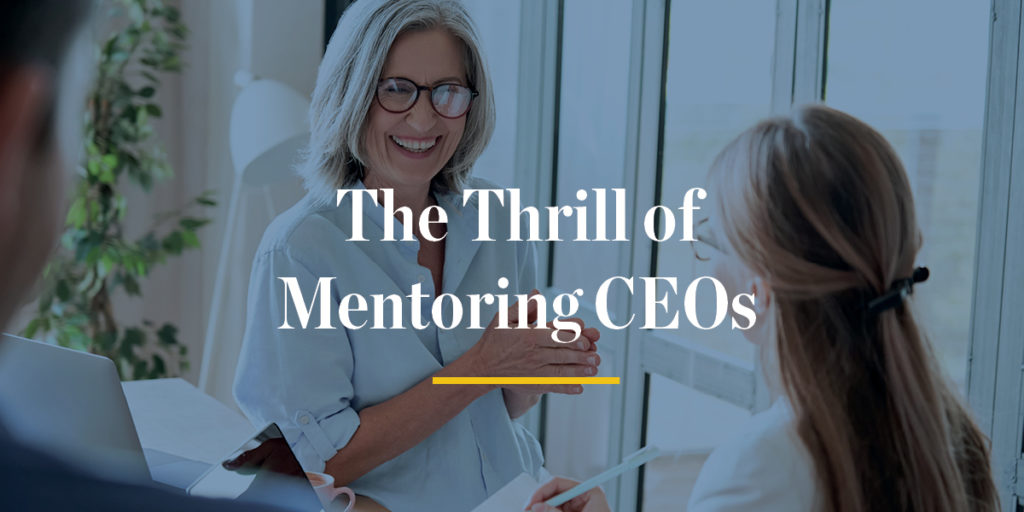The thrill of mentoring CEOs

The shark’s fearsome mouth and glaring eyes are etched in my memory. The primeval predator cruised past me just a couple feet away during a shark dive off the Caribbean island of Roatán. I couldn’t resist touching the cold, hard flesh of his flank as he brushed past me, just for the thrill and wonder of it.
I’ve had other exhilarating adventures. Nothing beats proving you can right your kayak from a flip even in whitewater. Then there was the bungee-jumping from a mountain-top tower. And the daredevil chasm leap on a volcanic formation in Katmai National Park, Alaska.
Not all of the adventures were illustrious. In my teens, I wrapped a canoe around a rock in a rapids on the Allagash River in Maine. (I was fine, but the canoe was totaled.)
Venturing out of my comfort zone also served me well in professional life. When we push against our limits, we learn, grow and (sometimes) triumph. Outdoor adventuring and leading a company actually have much in common. Both require plunging into the unknown. Both test your mettle and expand your horizons. And both can present opportunities to learn from and teach your peers.




A new adventure
I am a mentor by nature; it’s my passion. Speaking as a former camp counselor, soccer coach, schoolteacher, general manager and management consultant, mentoring has consistently been the most satisfying part of leading.
In recent years, I realized that guiding CEOs to become better leaders is the adventure I wanted most. So when the timing was right for leading a Vistage CEO peer advisory group, I seized the opportunity.
CEOs are under constant pressure to have the answers and provide direction in the face of uncertainty. That is why CEOs benefit so much from being in a peer group where they can think out loud and get perspectives from their peers. It is easy to get stuck thinking in circles when pondering management decisions alone. The dynamic of a CEO peer group forces you out of circular thinking and helps you hurdle your mental obstacles.
There is tremendous value in turning to peers to challenge and drive us. Peers help us see ourselves from the outside. They remind us of our unique abilities and expose parts of us that need growth. Peers provide a place to share and grow that you just cannot get from your board or staff at work.
Superlative CEOs
The CEOs in my group are fantastic. They are high-performing individuals intent on improving their leadership development and driven to achieve great results. They are adventurous, curious, open and generous in helping each other. They are also diverse: ages 40 to 75…high school grads and MBAs…residents of San Francisco, Marin and the East Bay. They are all from different industries, including apparel, food, agriculture, business brokerage, cybersecurity, engineering and wellness.
These CEOs have all sorts of leadership challenges — from how to market in the digital age to creating the right corporate culture. It is gratifying to watch group members help one another with business, technical and personal challenges. It is a thrill to see a member’s face light up when their internal light bulb switches on to a new insight.
The art of mentoring
As a CEO guide and mentor, here are three ways I approach the role for optimal connection with CEOs.
Never miss a good opportunity to stop talking.
Executive coaching is about skillful listening. When you are talking, you are not listening. A pause in the conversation can be valuable. It gives the CEO space to think deeply. It forces them to fill the silence, and what they fill it with may be revealing. Silence is golden.
Drill down the body.
Go from the head, to the heart to the gut. That means explore what your CEO thinks (head), feels (heart) and believes (gut). What a CEO thinks is a product of their feelings and not just their intellect. These thoughts and feelings are manifestations of their belief system. Belief systems are mainly unconscious and largely a product of childhood. They are assumptions about how the world works or should work. These assumptions often appear to the CEO as truths, rather than as assumptions…at least until you get them to examine their underlying beliefs.
Empathy is superior to commonality.
When reacting to the CEO’s situation, do not react by telling a story of when you were in a similar situation (commonality). Your story moves the focus from the CEO — where it belongs — to you, the coach. It also creates an issue in the CEO’s mind about whether the two situations are indeed alike. So instead of a story that shows commonality, tap into your emotional intelligence to express empathy through word and demeanor.
You can still find me kayaking and scuba diving. But my most exhilarating adventures these days are conversations with CEOs that explore marketing, scaling, recruiting, inspiring, financing and exiting.
Category: Personal Development
Tags: executive coaching, leadership development, Mentoring, Vistage Chair

